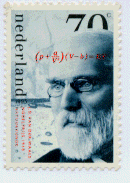|
The term ‘van der Waals’ force’ has sometimes been used to mean only forces involving temporary dipoles, and this is not correct. The van der Waals forces, that is forces between molecules having closed shells, consist of several types of interaction. They do not ‘obey’ inverse square laws like that of the electrostatic force between point charges. They make varying contributions to the overall intermolecular force. They also differ in their temperature-dependence. There are three attractive contributions:
In addition there are repulsive forces which exist when molecules approach closely: The orientation effect (dipole-dipole): The interaction energy of two permanent dipoles depends on their relative orientation, and might be expected to be zero overall for a compound if all orientations are possible. This would be true if the molecules were completely free to rotate, but they are not and some orientations are preferred over others. The energy of interaction varies as 1/r6, the force between the dipoles as 1/r7. It is inversely dependent upon the temperature. In a solid the interaction energy varies as 1/r3. The induction effect (permanent dipole-induced dipole): This also varies as 1/r6, but unlike the previous case it is independent of temperature. Its magnitude depends on the polarizability of the molecule. The dispersion effect or London force (temporary dipole-induced dipole): This is the only force of interaction in non-polar molecules, and arises from a temporary dipole inducing a complementary dipole in an adjacent molecule. These dipoles are always shifting, but are induced in phase and give a net attraction. They depend on the polarizability of the molecule, and vary as 1/r6. The effect is called the dispersion effect since the electronic movement that gives rise to it also causes dispersion of light, that is the variation of refractive index of a substance with the frequency (colour) of the light. Each of the above can be calculated for pairs of molecules; however the extension to many molecules is, quantitatively, not a simple matter. The repulsive forces are of much shorter range than the attractive ones. One
model uses a 1/r12 relationship, but agreement with experiment using
this is not always very good, and there are alternative, better, exponential expressions. Examples of the extent of the various contributions. The table gives the relative magnitudes of molecular interaction effects.
There are some points to note here. HCl is often presented as a molecule with permanent dipole-dipole forces – but they account for only about 15% of the intermolecular bonding, the rest being dispersion forces. Ammonia is roughly 50:50, and water’s permanent dipoles dominate – hydrogen bonding being highly significant in both these latter cases.
|
 Johannes Diderik van der Waals (1837 - 1923) Nobel Prize for Physics 1910 | |||||||||||||||||||||||||||||||||||||||||||||||||||||||||||